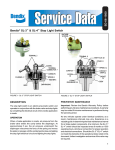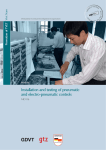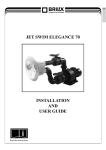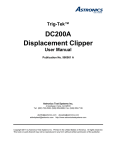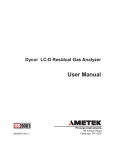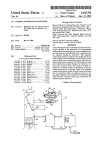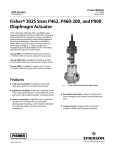Download BENDIX BW1595 User's Manual
Transcript
SD-06-1801 ® Bendix® TE-1™ Trailer Emergency Stop Light Switch TERMINALS SPRING DIAPHRAGM PLUNGER FIGURE 1 TE-1™ TRAILER EMERGENCY STOP LIGHT SWITCH IN TP-2™, TW-1™ TRACTOR PROTECTION SYSTEM. TW-1™ TWO WAY CONTROL VALVE TE-1™ TRAILER EMERGENCY STOP LIGHT SWITCH IN TP-3™, PP-3™ TRACTOR PROTECTION SYSTEM. PP-3™ TRAILER SUPPLY VALVE SUPPLY SUPPLY SUPPLY AND MOUNTING PORT OPTIONAL TE-1™ TRAILER EMERGENCY STOP LIGHT SWITCH SUPPLY POINTS TP-2™ TRACTOR PROTECTION VALVE SUPPLY AND MOUNTING PORT OPTIONAL TE-1™ TRAILER EMERGENCY STOP LIGHT SWITCH SUPPLY POINTS TP-3™ TRACTOR PROTECTION VALVE TRAILER EMERGENCY TRAILER EMERGENCY FIGURE 2 FIGURE 3 DESCRIPTION If air pressure in the air brake system reduces to approximately 60* psi for any reason, the spring overcomes the pressure under the diaphragm, closes the contacts and lights both tractor and trailer stop lights. The trailer emergency stop light switch is an electropneumatic switch and lights the trailer stop lights if pressure in the tractor emergency line reduces to approximately 60* psi for any reason, or if the tractor protection valve is operated manually. Continued reduction of air pressure will disconnect tractor stop lights but the trailer stop light will continue to light. Referring to Figure 1 (Sectional View), with air pressure above approximately 60* psi in the line in which the switch is connected, air pressure acting upon the diaphragm under the plunger overcomes pressure of the spring and keeps the contacts separated. *Older switches were set at 55 psi. 1 TE-1™ TRAILER EMERGENCY STOP LIGHT SWITCH WIRING DIAGRAM ACCESSORY POLE, IGNITION SWITCH, ETC., THAT IS OFF WHEN ENGINE IS OFF TRACTOR STOP LIGHT SWITCH TRACTOR STOP LIGHTS IGN TLR BATTERY TE-1™ TRAILER EMERGENCY STOP LIGHT SWITCH ELECTRICAL COUPLING TTR TRAILER STOP LIGHTS FIGURE 4 PREVENTIVE MAINTENANCE Important: Review the Bendix Warranty Policy before performing any intrusive maintenance procedures. A warranty may be voided if intrusive maintenance is performed during the warranty period. REMOVING A. Place tractor protection control valve in emergency position. B. Disconnect electrical connections at switch. C. Remove switch. No two vehicles operate under identical conditions; as a result, maintenance intervals may vary. Experience is a valuable guide in determining the best maintenance interval for air brake system components. At a minimum, the TE-1™ valve should be inspected every 6 months or 1500 operating hours, whichever comes first, for proper operation and electrical connections. Should the TE-1™ valve not meet the elements of the operational tests noted in this document, further investigation and service of the valve may be required. INSTALLING TESTING FOR SERVICEABILITY WARNING! PLEASE READ AND FOLLOW THESE INSTRUCTIONS TO AVOID PERSONAL INJURY OR DEATH: A. Operating Test 1. With ignition switch on and system fully charged, make and hold a foot valve application and note that stop lights on tractor and trailer are functioning properly. 2. Place tractor protection control valve in the emergency position and note that the trailer stop lights are functioning properly. 3. Place tractor protection control valve in normal position and reduce air pressure in system by making several foot valve applications or by slowly draining reservoirs and observing dash gauge; note that trailer stop lights function at approximately 60* psi. B. Leakage Test Coat the entire switch with soap solution and check for leaks; no leakage permitted. If the trailer emergency stop light switch does not function as described or if leakage is present, it is recommended that the switch be replaced with a new switch available at the nearest Bendix authorized distributor. No attempt should be made to disassemble and repair faulty switch. *Older switches were set at 55 psi. 2 (Refer to piping diagrams - Figure 2 and Figure 3.) A. Install in delivery port of tractor protection control valve or in control line between control valve and tractor protection valve. Alternate installation can be made with a tee connection off the emergency line after the tractor protection valve. B. Wire as per wiring diagram (Figure 4). When working on or around a vehicle, the following general precautions should be observed at all times. 1. Park the vehicle on a level surface, apply the parking brakes, and always block the wheels. Always wear safety glasses. 2. Stop the engine and remove ignition key when working under or around the vehicle. When working in the engine compartment, the engine should be shut off and the ignition key should be removed. Where circumstances require that the engine be in operation, EXTREME CAUTION should be used to prevent personal injury resulting from contact with moving, rotating, leaking, heated or electrically charged components. 3. Do not attempt to install, remove, disassemble or assemble a component until you have read and thoroughly understand the recommended procedures. Use only the proper tools and observe all precautions pertaining to use of those tools. 4. If the work is being performed on the vehicle’s air brake system, or any auxiliary pressurized air systems, make certain to drain the air pressure from all reservoirs before beginning ANY work on the vehicle. If the vehicle is equipped with an AD-IS™ air dryer system or a dryer reservoir module, be sure to drain the purge reservoir. 5. Following the vehicle manufacturer’s recommended procedures, deactivate the electrical system in a manner that safely removes all electrical power from the vehicle. 6. Never exceed manufacturer’s recommended pressures. 7. Never connect or disconnect a hose or line containing pressure; it may whip. Never remove a component or plug unless you are certain all system pressure has been depleted. 8. Use only genuine Bendix ® replacement parts, components and kits. Replacement hardware, tubing, hose, fittings, etc. must be of equivalent size, type and strength as original equipment and be designed specifically for such applications and systems. 9. Components with stripped threads or damaged parts should be replaced rather than repaired. Do not attempt repairs requiring machining or welding unless specifically stated and approved by the vehicle and component manufacturer. 10. Prior to returning the vehicle to service, make certain all components and systems are restored to their proper operating condition. 3 BW1595 © 2004 Bendix Commercial Vehicle Systems LLC All rights reserved. 3/2004 Printed in U.S.A. 4




